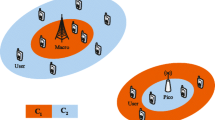Abstract
Recently, it is widely believed that significant coverage and performance improvement can be achieved through the deployment of small cells in conjunction with the well-established macro cells. However, it is expected that the high density of base stations in such heterogeneous cellular networks will give rise to multiple design problems related to both co-tier (small-to-small) and cross-tier (between small and macro cells) interference. Fortunately, cooperation between base stations will play a major role to cope with these problems and hence to enhance the users’ data rates. In this paper, we consider a two-tier cellular network comprised of a macro cell underlaid with multiple small cells where both co-tier and cross-tier interference are taken into account. We study the scenario where the small cell base stations seek to maximize a common objective by forming multiple clusters through cooperation. These base stations have also to allocate power to their associated users and, at the same time, control the total aggregate interference caused to the macro cell user which has to be kept below a threshold prefixed by the macro cell base station. We consider two utility functions: the overall sum rate of the small cell network and the minimum data rate of the small cell users. We formulate the studied problems as mixed integer nonlinear optimization problems and we discuss their NP hardness. Therefore, due to the complexity of finding the optimal solution, we design heuristic algorithms which resolves efficiently the tradeoff between computational complexity and performance. We show through simulations that the designed heuristics approach the optimal solution (obtained using the complex exhaustive search algorithm) with highly reduced computational complexity.










Similar content being viewed by others
References
Andrews, J. (2013). Seven ways that HetNets are a cellular paradigm shift. IEEE Communication Magazine, 51(3), 136–144.
Gesbert, D., Hanly, S., Huang, H., Shamai Shitz, S., Simeone, O., & Yu, W. (2010). Multi-cell MIMO cooperative networks: A new look at interference. IEEE Journal on Selected Areas in Communications, 28(9), 1380–1408.
Akyildiz, I., Lee, W.-Y., Vuran, M. C., & Mohanty, S. (2008). A survey on spectrum management in cognitive radio networks. IEEE Communications Magazine, 46(4), 40–48.
Yoo, T., & Goldsmith, A. (2006). On the optimality of multiantenna broadcast scheduling using zero-forcing beamforming. IEEE Journal on Selected Areas in Communications, 24(3), 528–541.
Driouch, E., & Ajib, W. (2013). Downlink scheduling and resource allocation for cognitive radio MIMO networks. IEEE Transactions on Vehicular Technology, 62(8), 3875–3885.
Boccardi, F., & Huang, H. (2006). Zero-forcing precoding for the MIMO broadcast channel under per-antenna power constraints. In Proceedings of IEEE SPAWC’06.
Zhang, R. (2010). Cooperative multi-cell block diagonalization with per-base-station power constraints. IEEE Journal on Selected Areas in Communications, 28(9), 1435–1445.
Kaviani, S., & Krzymień, W. A. (2011). Optimal multiuser zero forcing with per-antenna power constraints for network MIMO coordination. EURASIP Journal on Wireless Communications and Networking, 2011, 1–12.
Zeng, Y., Gunawan, E., & Guan, Y. L. (2012). Modified block diagonalization precoding in multicell cooperative networks. IEEE Transactions on Vehicular Technology, 61(8), 3819–3824.
Nguyen, D., Nguyen-Le, H., & Le-Ngoc, T. (2014). Block-diagonalization precoding in a multiuser multicell MIMO system: Competition and coordination. IEEE Transactions on Wireless Communications, 13(2), 968–981.
Wang, X., Zhu, P., Sheng, B., & You, X. (2013). Energy-efficient downlink transmission in multi-cell coordinated beamforming systems. In Proceedings of IEEE wireless communications and networking conference (WCNC) (pp. 2554–2558).
Sakr, A., & Hossain, E. (2014). Energy-efficient downlink transmission in two-tier network MIMO OFDMA networks. In Proceedings of IEEE international conference on communications (ICC) (pp. 3652–3657).
Maso, M., Debbah, M., & Vangelista, L. (2013). A distributed approach to interference alignment in OFDM-based two-tiered networks. IEEE Transactions on Vehicular Technology, 62(5), 1935–1949.
Maso, M., Cardoso, L., Debbah, M., & Vangelista, L. (2013). Cognitive orthogonal precoder for two-tiered networks deployment. IEEE Journal on Selected Areas in Communications, 31(11), 2338–2348.
Guruacharya, S., Niyato, D., Bennis, M., & Kim, D. I. (2013). Dynamic coalition formation for network MIMO in small cell networks. IEEE Transactions on Wireless Communications, 12(10), 5360–5372.
Mochaourab, R., & Jorswieck, E. (2014). Coalitional games in MISO interference channels: Epsilon-core and coalition structure stable set. IEEE Transactions on Signal Processing, 62(24), 6507–6520.
Pantisano, F., Bennis, M., Saad, W., Debbah, M., & Latva-Aho, M. (2013). Interference alignment for cooperative femtocell networks: A game-theoretic approach. IEEE Transactions on Mobile Computing, 12(11), 2233–2246.
Zhang, Z., Song, L., Han, Z., & Saad, W. (2014). Coalitional games with overlapping coalitions for interference management in small cell networks. IEEE Transactions on Wireless Communications, 13(5), 2659–2669.
Luo, Z.-Q., & Zhang, S. (2008). Dynamic spectrum management: Complexity and duality. IEEE Journal of Selected Topics in Signal Processing, 2(1), 57–73.
Le, L. B., & Hossain, E. (2008). Resource allocation for spectrum underlay in cognitive radio networks. IEEE Transactions on Wireless Communications, 7(12), 5306–5315.
Wang, R., & Lau, V. K. N. (2007). Cross layer design of downlink multi-antenna ofdma systems with imperfect CSIT for slow fading channels. IEEE Transactions on Wireless Communications, 6(7), 2417–2421.
Author information
Authors and Affiliations
Corresponding author
Rights and permissions
About this article
Cite this article
Driouch, E., Ajib, W. & Assi, C. Power control and clustering in heterogeneous cellular networks. Wireless Netw 23, 2509–2520 (2017). https://doi.org/10.1007/s11276-016-1299-7
Published:
Issue Date:
DOI: https://doi.org/10.1007/s11276-016-1299-7




